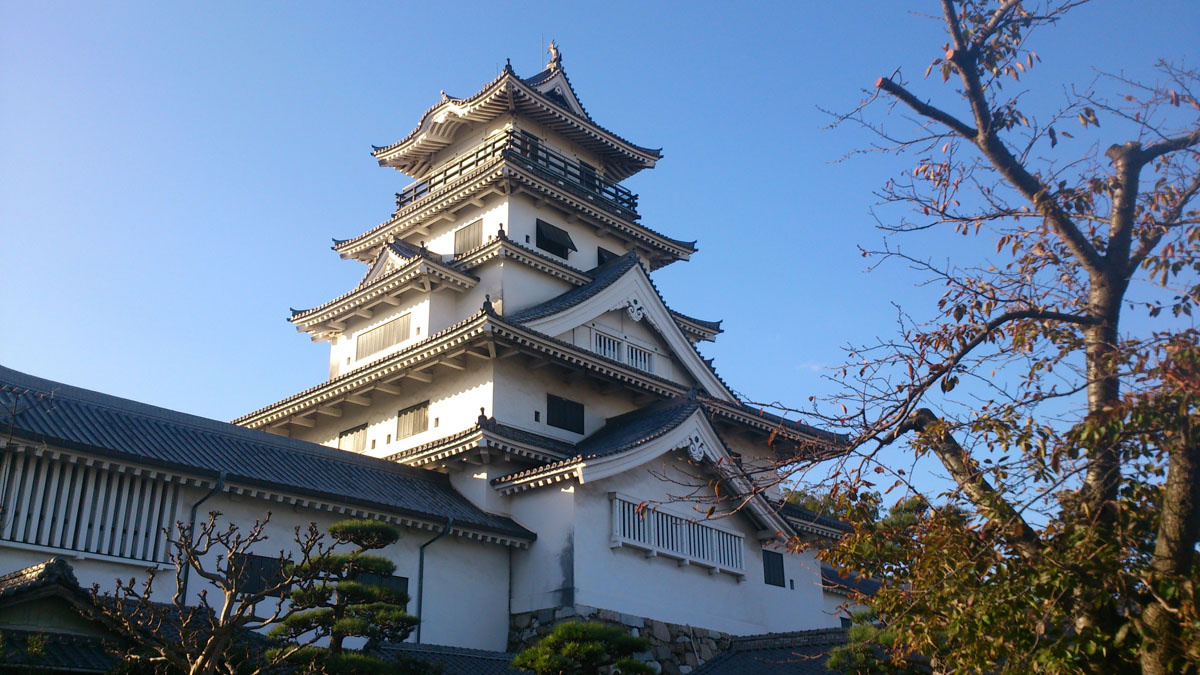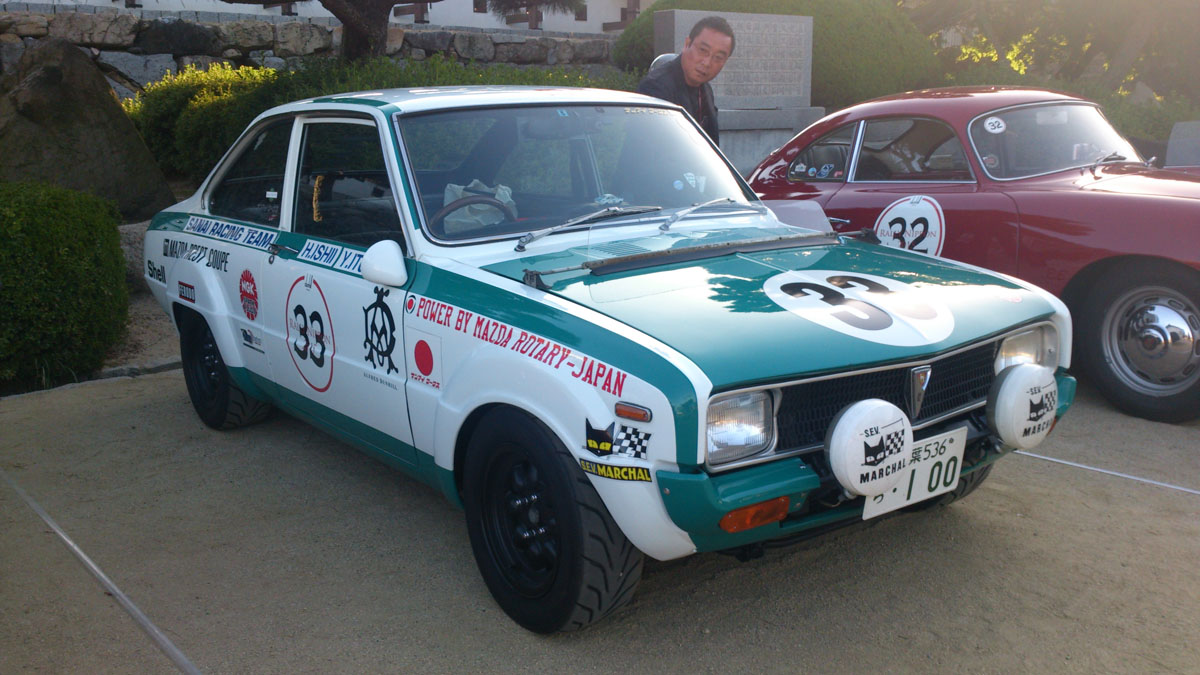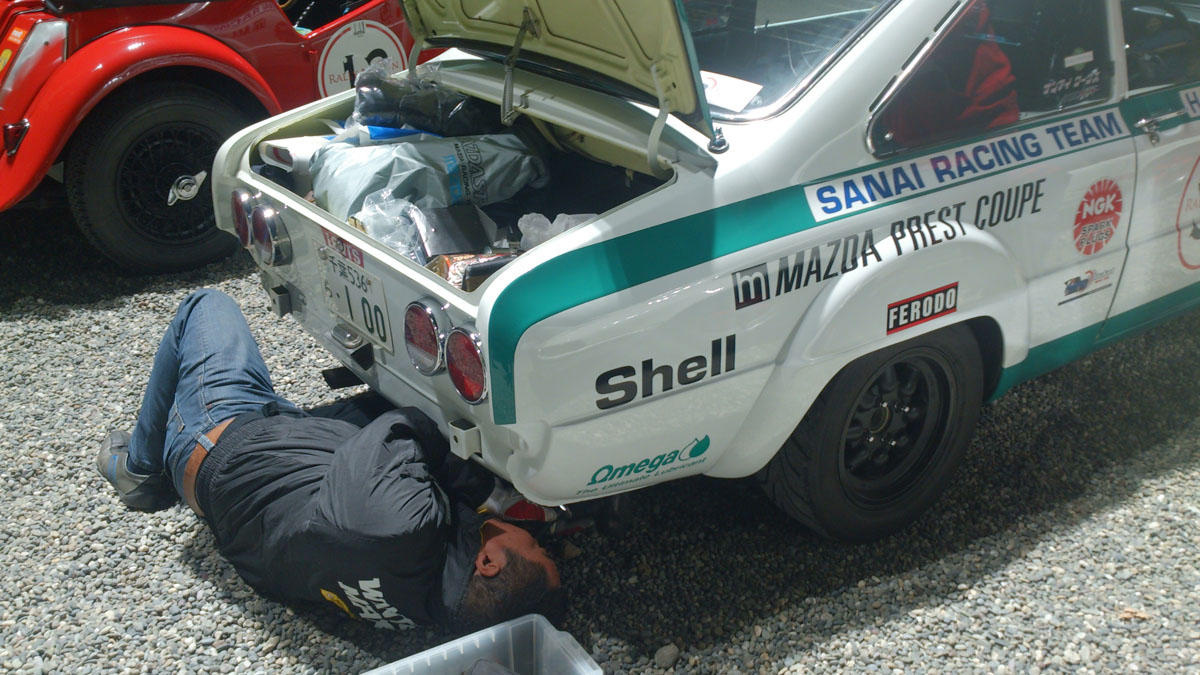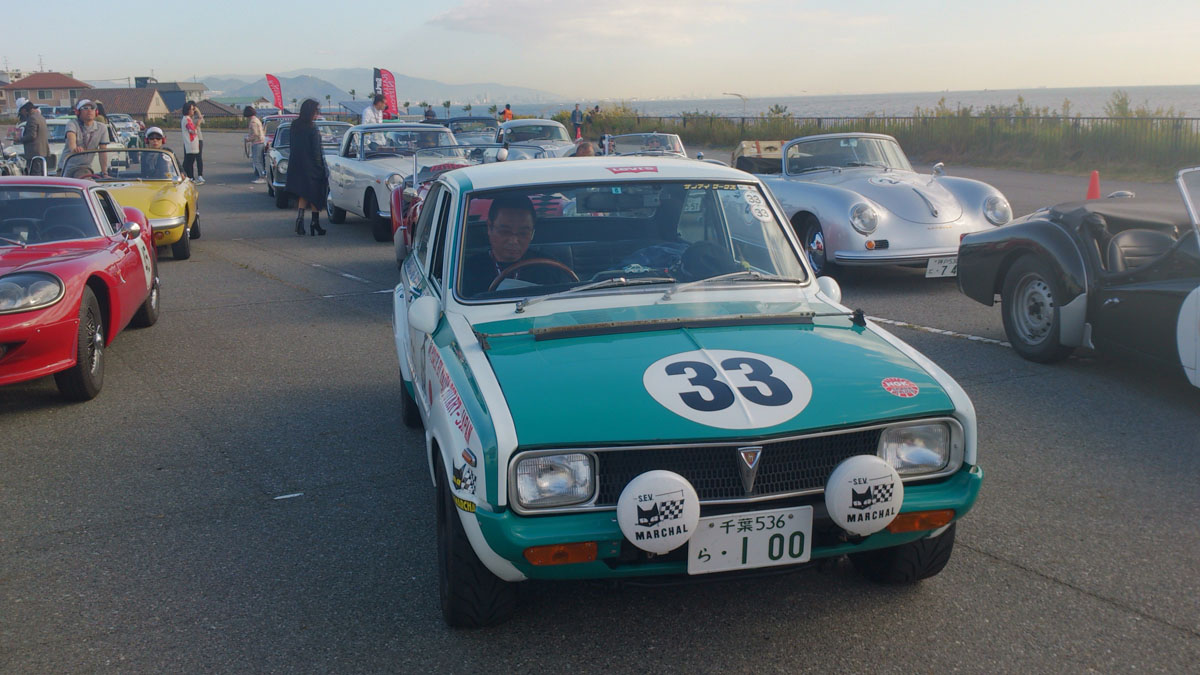- 2015/11/08
Hirokart Ito’s Rally Japan R100 Competition Diary 2015
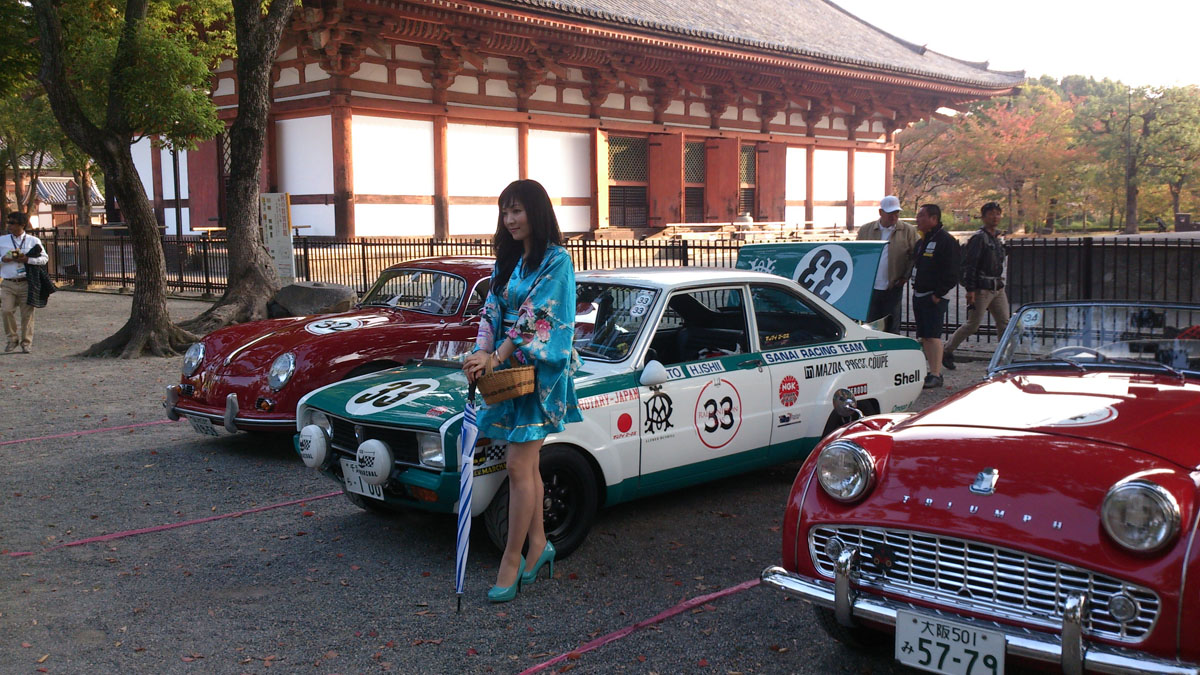
This year the Familia Rotary Coupe (R100) of Ito and Sanai Works’ Ishii competed in the Rally Nippon. A competition diary has been sent to us from Ito. The route for Rally Nippon, a project aiming to support the revitalization of Japan, was from Kyoto, through the surrounds of Shikoku, then back to Kyoto. This was the event’s first time to venture to Shikoku and it was held over October 24th (Sat) to October 27th (Tues). What kind of scenery did they see out of their windscreen over those three days? Let see what Ito had to say.
1.History
2010 was the time when I, someone who has driven an RX-7 for three decades, decided to participate in the Rally Nippon behind the wheel of a Familia Rotary Coupe (R100). That year, through an unexpected turn of events, I ended up borrowing the MGA of Gagaku artist, Hideki Togi (founder, director and yearly competitor of Rally Nippon) and competed in Rally Nippon. Until that point I had never competed in a classic car event and after the four days of experiencing the atmosphere of Rally Nippon, seeing the numerous fine vehicles, meeting so many young and old car enthusiasts in every location and feeling their warm welcome, I declared that, “Next year I’m competing here in my own car!” Of course, when I say compete in my own vehicle, my only choice was to use a rotary. The vehicle regulations for Rally Nippon call for automobiles produced before 1974 that ran on public roads and so, with that in mind, my choice was either a Cosmo Sport or a Familia.
For me it was the R100, no question. Although only a limited number of Cosmo Sports were manufactured and they are, in their own right, quite valuable cars, there are already a number of well-established owners’ groups and you see them quite often. So in that way the R100 is a lot more rare. If I was going to use one of these, then I definitely wanted to go out using the works colors of the team that competed in the ‘69 24 Hours of Spa-Francorchamps (Belgium). After consulting with Sanai Works president Ishii, who has assisted me with my vehicles for a number of years, he expressed his desire to not only support but officially compete. So it became a combined Sanei + Hirokart team that went out into Rally Nippon 2011 (Tokyo to Kyoto).
Although we had the will we still needed the car and, after an exhaustingly extensive search, we finally found a 1970 base vehicle. After that Sanai Works began to restore the body, chassis and engine. After that we took an EBBRO 1970 Spa-spec R100 (current car dash board display) minicar to sprayers and decal printers who recreated the original coloring and stickers of the competition car.
In 1970 the Mazda Works team entered 4 machines (car numbers 31-40) into Spa. We eventually came to the idea of creating four R100 replicas and bringing them all out for competition. We were incredibly lucky to discover our second base vehicle in 2011 Rally Nippon at Nagahama, near the shores of Lake Biwa and we made the prompt decision to buy it. We restored this as the #32 car and entered into the 2012 Rally Nippon (Kyoto to Tokyo) as a two-machine team. After that we competed 7 times in the 2013 Rally Nippon in Y154 (Yokohama), 2014 Rally Tokyo Yokohama (Tokyo to Chiba to Miura Peninsula to Yokohama), Rally Japan (Fukuoka → Kyoto), 2015 Rally Tokyo Yokohama (Yokohama → Miura Peninsula → Yokohama), and then this Rally Nippon (Kyoto → Shikoku → Kyoto) and completed every single event.
2.Regarding Rally Nippon
Rally Nippon is usually competed over four days (for Spring Tokyo-Yokohama 2 days), and most years it is held in late October or early November after the La Festa Mille Miglia. The event runs for approximately 1,000-1,200km over the four days, with 3-4 timed stages (PCs – pass controls) a day. Competing vehicles run along the course leg frame points and aim to arrive at each PC or checkpoint before or by a predetermined time. The order is determined by calculating the total points through measuring the time difference between PCs, but deductions are made for missing any checkpoints, and traffic violations result in disqualifications. Each leg is a lot more relaxed than Mille Miglia, and since the competition for PCs is less intense, more than a competitive rally, it acts like a parade run where participants can show off their beloved cars and wave to the spectators on the side of the road. It almost has the feel of an enjoyable road trip. At each PC or Rest Control stage, a welcome event is held with the cooperation of the local towns, organizations, police, etc. and the 70-80 classic cars perform a parade to the delight of the residents. In order to enliven the event we bring along campaign girls who are present right from the beginning to give out team novelty goods at every event (special R100 straps, stickers, etc.).
We are committed to the idea that there is significance in just participating (:P) and we ranked 30 out of the 70 competitors. Up until now the results for the R100 have been, on a good year, around 20th, on a bad year, around 40th. My personal best would be when I borrowed Togi’s car in 2010 and finished 19th… (sigh). In order to get into the top-10, as with any other rally, you really need to push the line to 1/100s of a second in the PCs. That isn’t really possible if you haven’t carried out very precise practice runs. Although Togi boasts that he can get into the top group without practicing, and was in the top-10 in the first days of Rally Nippon, for the past two years he hasn’t been able to manage it and in this rally he finished 21st. It’s pretty clear that the level of regular participants is rapidly getting better.
3.This year’s Rally Nippon
This year’s starting location was within the precinct of Toji Temple, Kyoto. Last year’s starting location was Daizafu, Fukuoka and at that time I requested the help of a vehicle supplier to help transport my machine to the location. This time around though I used my beloved RX-8 to transport the car. This year our staffing situation was limited so we only competed with one entry, the #33, with Sanei’s president Ishii driving and myself navigating.
The first day was sunny and perfect weather for rallying. This year was unusual in that, for the first time since 2010, the entire four days were blessed with fine weather, so those competing in Barchettas, which don’t have much in the way of a hood, were delighted. The event began as scheduled at 8:45am from the #1, after which, one by one in 30-second intervals, the 73 competitors, guest participants and marshall cars headed out under the eyes of a large group of spectators and made their way towards Awaji Island.
After that, the procession made their way through Awaji Island SA Highway Oasis, the first measured PC, a lunch rest control, Zentsuji, Kotohira Station, Mt. Ishizuchi checkpoint, and so on, to finally make it to the final location, Imabari Castle. Every vehicle then went into storage within the special paddock established within the caste. Up to this point we, in our R100, drove along in good condition, hitting all the measurement lines and made no serious mistakes. This was the most stress-free first day we had ever had and I slept like a baby.
The second day started from Imabari Castle, took Shimanami Kaido over Oshima and checked in at Yoshimi Ikiiki Museum for PC. By way of Dogo Onsen Station checkpoint we then went through the Matsuyama Shiroyama Park PC, Ozu-Machi Eki Asamoya Checkpoint, Tenshaen lunch rest control, Cape Muroto and Wamachi checkpoint, Michi no Eki Aguri Kubokawa checkpoint, to the goal of Kochi Castle. Here we passed the last checkpoint and were flying through Kochi motorway when we suddenly experienced some engine trouble. There began to be some knocking coming from the engine and we lost pace, so Ishii decided to get off at Tosa Interchange and inspect the car. Apparently Ishii had been having misgivings since he we brought the car to Kyoto. He felt that at full throttle the power of the engine had been poor and suspected that there may be a problem with the fuel system. This man clearly has the instincts of a rotary doctor.
Ishii went on to say, “There’s something wrong with the carburetor or fuel system. There’s either a clog or a problem with the fuel pump.” Somehow we managed to make it to Kochi Castle and after that we immediately got to work replacing the fuel pump. Ishii gave his diagnosis, “This will either fix the problem or, if the carburetor is unable to respond at high revs or load, then we know it’s a fuel shortage problem.” Taking a complete turn from the first day, I bedded down in Kochi racked with anxiety.
The third day began from the special paddock within Kochi Castle. Passing through the first PC at the Actland Shikoku Automobile Museum, Michi no Eki Tanoekiya checkpoint, Toyocho Umi no Eki PC and lunch rest control, Anan City Sports Center PC, then the Tokushima BMW checkpoint, we pulled away from Shikoku and finished at Awaji Island Westin Hotel.
Having narrowed down the problem to a malfunction in the carburetor, Ishii drove while being conscious of the lack of fuel and pressure at high rotations and avoided causing excessive knocking as much as possible. Not being able to compete at full speed was quite vexing.
The last day saw the rally go from Awaji Island to Honshu. The morning saw us pass through Yumebutai Carpark, then cross to Kobe, Michi no Eki Inagawa checkpoint, Kameoka, Kameoka PC (where a real Lancia Stratos works car was on display), Rakurakuso lunch control, Kyoto Katsura, pass through Togetsukyo, Arashiyama Takao Parkway checkpoint, then leave Kyoto to reach the finish line of Kamigamo Shrine. The last day’s travel distance was relatively short and the awards ceremony was held at 3:00pm after which we checked into the Hyatt Regency Tokyo. The awards party saw the usual conviviality and was rounded off with an impromptu performance from Hideki Togi. On the next day we began our 500km journey back to Makuhari in the R100, being exceedingly careful not to push the car too hard, and then finally our long journey came to a conclusion.
Hirokart Racing Team Superintendant
Hirokart Ito
Photo by h.ito
1.History
2010 was the time when I, someone who has driven an RX-7 for three decades, decided to participate in the Rally Nippon behind the wheel of a Familia Rotary Coupe (R100). That year, through an unexpected turn of events, I ended up borrowing the MGA of Gagaku artist, Hideki Togi (founder, director and yearly competitor of Rally Nippon) and competed in Rally Nippon. Until that point I had never competed in a classic car event and after the four days of experiencing the atmosphere of Rally Nippon, seeing the numerous fine vehicles, meeting so many young and old car enthusiasts in every location and feeling their warm welcome, I declared that, “Next year I’m competing here in my own car!” Of course, when I say compete in my own vehicle, my only choice was to use a rotary. The vehicle regulations for Rally Nippon call for automobiles produced before 1974 that ran on public roads and so, with that in mind, my choice was either a Cosmo Sport or a Familia.
For me it was the R100, no question. Although only a limited number of Cosmo Sports were manufactured and they are, in their own right, quite valuable cars, there are already a number of well-established owners’ groups and you see them quite often. So in that way the R100 is a lot more rare. If I was going to use one of these, then I definitely wanted to go out using the works colors of the team that competed in the ‘69 24 Hours of Spa-Francorchamps (Belgium). After consulting with Sanai Works president Ishii, who has assisted me with my vehicles for a number of years, he expressed his desire to not only support but officially compete. So it became a combined Sanei + Hirokart team that went out into Rally Nippon 2011 (Tokyo to Kyoto).
Although we had the will we still needed the car and, after an exhaustingly extensive search, we finally found a 1970 base vehicle. After that Sanai Works began to restore the body, chassis and engine. After that we took an EBBRO 1970 Spa-spec R100 (current car dash board display) minicar to sprayers and decal printers who recreated the original coloring and stickers of the competition car.
In 1970 the Mazda Works team entered 4 machines (car numbers 31-40) into Spa. We eventually came to the idea of creating four R100 replicas and bringing them all out for competition. We were incredibly lucky to discover our second base vehicle in 2011 Rally Nippon at Nagahama, near the shores of Lake Biwa and we made the prompt decision to buy it. We restored this as the #32 car and entered into the 2012 Rally Nippon (Kyoto to Tokyo) as a two-machine team. After that we competed 7 times in the 2013 Rally Nippon in Y154 (Yokohama), 2014 Rally Tokyo Yokohama (Tokyo to Chiba to Miura Peninsula to Yokohama), Rally Japan (Fukuoka → Kyoto), 2015 Rally Tokyo Yokohama (Yokohama → Miura Peninsula → Yokohama), and then this Rally Nippon (Kyoto → Shikoku → Kyoto) and completed every single event.
2.Regarding Rally Nippon
Rally Nippon is usually competed over four days (for Spring Tokyo-Yokohama 2 days), and most years it is held in late October or early November after the La Festa Mille Miglia. The event runs for approximately 1,000-1,200km over the four days, with 3-4 timed stages (PCs – pass controls) a day. Competing vehicles run along the course leg frame points and aim to arrive at each PC or checkpoint before or by a predetermined time. The order is determined by calculating the total points through measuring the time difference between PCs, but deductions are made for missing any checkpoints, and traffic violations result in disqualifications. Each leg is a lot more relaxed than Mille Miglia, and since the competition for PCs is less intense, more than a competitive rally, it acts like a parade run where participants can show off their beloved cars and wave to the spectators on the side of the road. It almost has the feel of an enjoyable road trip. At each PC or Rest Control stage, a welcome event is held with the cooperation of the local towns, organizations, police, etc. and the 70-80 classic cars perform a parade to the delight of the residents. In order to enliven the event we bring along campaign girls who are present right from the beginning to give out team novelty goods at every event (special R100 straps, stickers, etc.).
We are committed to the idea that there is significance in just participating (:P) and we ranked 30 out of the 70 competitors. Up until now the results for the R100 have been, on a good year, around 20th, on a bad year, around 40th. My personal best would be when I borrowed Togi’s car in 2010 and finished 19th… (sigh). In order to get into the top-10, as with any other rally, you really need to push the line to 1/100s of a second in the PCs. That isn’t really possible if you haven’t carried out very precise practice runs. Although Togi boasts that he can get into the top group without practicing, and was in the top-10 in the first days of Rally Nippon, for the past two years he hasn’t been able to manage it and in this rally he finished 21st. It’s pretty clear that the level of regular participants is rapidly getting better.
3.This year’s Rally Nippon
This year’s starting location was within the precinct of Toji Temple, Kyoto. Last year’s starting location was Daizafu, Fukuoka and at that time I requested the help of a vehicle supplier to help transport my machine to the location. This time around though I used my beloved RX-8 to transport the car. This year our staffing situation was limited so we only competed with one entry, the #33, with Sanei’s president Ishii driving and myself navigating.
The first day was sunny and perfect weather for rallying. This year was unusual in that, for the first time since 2010, the entire four days were blessed with fine weather, so those competing in Barchettas, which don’t have much in the way of a hood, were delighted. The event began as scheduled at 8:45am from the #1, after which, one by one in 30-second intervals, the 73 competitors, guest participants and marshall cars headed out under the eyes of a large group of spectators and made their way towards Awaji Island.
After that, the procession made their way through Awaji Island SA Highway Oasis, the first measured PC, a lunch rest control, Zentsuji, Kotohira Station, Mt. Ishizuchi checkpoint, and so on, to finally make it to the final location, Imabari Castle. Every vehicle then went into storage within the special paddock established within the caste. Up to this point we, in our R100, drove along in good condition, hitting all the measurement lines and made no serious mistakes. This was the most stress-free first day we had ever had and I slept like a baby.
The second day started from Imabari Castle, took Shimanami Kaido over Oshima and checked in at Yoshimi Ikiiki Museum for PC. By way of Dogo Onsen Station checkpoint we then went through the Matsuyama Shiroyama Park PC, Ozu-Machi Eki Asamoya Checkpoint, Tenshaen lunch rest control, Cape Muroto and Wamachi checkpoint, Michi no Eki Aguri Kubokawa checkpoint, to the goal of Kochi Castle. Here we passed the last checkpoint and were flying through Kochi motorway when we suddenly experienced some engine trouble. There began to be some knocking coming from the engine and we lost pace, so Ishii decided to get off at Tosa Interchange and inspect the car. Apparently Ishii had been having misgivings since he we brought the car to Kyoto. He felt that at full throttle the power of the engine had been poor and suspected that there may be a problem with the fuel system. This man clearly has the instincts of a rotary doctor.
Ishii went on to say, “There’s something wrong with the carburetor or fuel system. There’s either a clog or a problem with the fuel pump.” Somehow we managed to make it to Kochi Castle and after that we immediately got to work replacing the fuel pump. Ishii gave his diagnosis, “This will either fix the problem or, if the carburetor is unable to respond at high revs or load, then we know it’s a fuel shortage problem.” Taking a complete turn from the first day, I bedded down in Kochi racked with anxiety.
The third day began from the special paddock within Kochi Castle. Passing through the first PC at the Actland Shikoku Automobile Museum, Michi no Eki Tanoekiya checkpoint, Toyocho Umi no Eki PC and lunch rest control, Anan City Sports Center PC, then the Tokushima BMW checkpoint, we pulled away from Shikoku and finished at Awaji Island Westin Hotel.
Having narrowed down the problem to a malfunction in the carburetor, Ishii drove while being conscious of the lack of fuel and pressure at high rotations and avoided causing excessive knocking as much as possible. Not being able to compete at full speed was quite vexing.
The last day saw the rally go from Awaji Island to Honshu. The morning saw us pass through Yumebutai Carpark, then cross to Kobe, Michi no Eki Inagawa checkpoint, Kameoka, Kameoka PC (where a real Lancia Stratos works car was on display), Rakurakuso lunch control, Kyoto Katsura, pass through Togetsukyo, Arashiyama Takao Parkway checkpoint, then leave Kyoto to reach the finish line of Kamigamo Shrine. The last day’s travel distance was relatively short and the awards ceremony was held at 3:00pm after which we checked into the Hyatt Regency Tokyo. The awards party saw the usual conviviality and was rounded off with an impromptu performance from Hideki Togi. On the next day we began our 500km journey back to Makuhari in the R100, being exceedingly careful not to push the car too hard, and then finally our long journey came to a conclusion.
Hirokart Racing Team Superintendant
Hirokart Ito
Photo by h.ito






